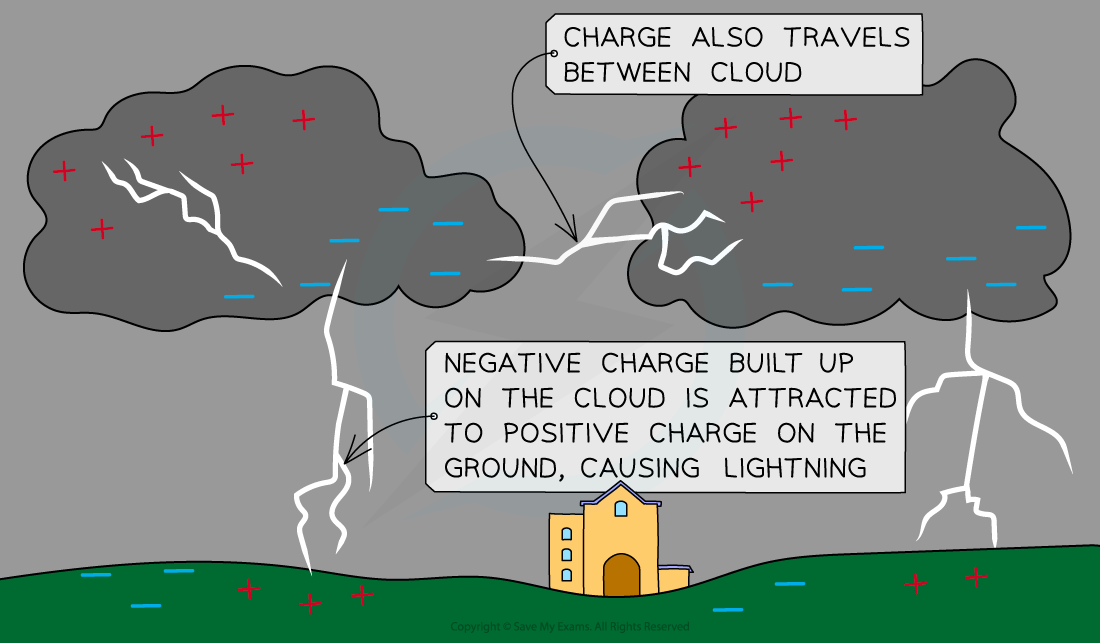Static Electricity (Oxford AQA IGCSE Physics)
Revision Note

Author
Ann HowellExpertise
Physics Content Creator
Static Electricity
Static electricity is caused by a build up of electrons on the surface of an insulating material
The charge is static or stationary because the electrons have no where to go such as through a conducting material
This results in the repulsion of oppositely charged objects
When a conducting route is provided the electrons can discharge by producing a spark
Generating static electricity
All objects are initially electrically neutral
They have even numbers of positive and negative charges
Rubbing two surfaces together transfers electrons from one object to the other
The object that has gained negative electrons becomes negatively charged
The object that loses negative electrons becomes positively charged
Remember that:
Protons are the positive charges in an atom's nucleus so they cannot be transferred
Whether a material gains or loses electrons during rubbing depends upon its properties
When an uncharged cloth is rubbed against an uncharged polythene rod
Electrons are transferred away from the cloth to the rod
The cloth has lost electrons so it becomes positively charged
The polythene rod has gained electrons so it becomes negatively charged
These oppositely charged objects are also attracted to each other
When an uncharged cloth is rubbed against an uncharged acetate plastic rod, however
Electrons are transferred away from the acetate rod to the cloth
The cloth has gained electrons so it becomes negatively charged
The rod has lost electrons so it becomes positively charged
Static charge transfer

Sticking a balloon to the wall:
Rubbing a balloon on a woollen jumper transfers electrons onto the balloon
The balloon is now negatively charged whilst the jumper is left positively charged
The wall is still neutral, however, when the balloon is placed near the wall, the electrons in the wall are repelled by the balloon creating a net positively charged are that the balloon is attracted to
Since opposite charges attract, the balloon sticks to the wall
Other examples of static electricity in everyday life are:
Dust and dirt attracted to TV screens and computer monitors
Dust build-up on the edges of a fan
Clothes clinging to each other after being in a tumble dryer, especially those made of synthetic fabrics
Hair sticking up after pulling a hat off
Combing dry hair with a plastic comb and the hair stays attracted to the comb
A child's hair sticking up after going down a plastic slide
Photocopiers use black powder to stick to white paper to create a copy of a document
Examples of static electricity

These experiences are most common in dry air conditions
When it is much harder for the charges to dissipate so they build up instead, and make static electricity more noticeable
Some of these can cause sparking
Sparking
When electrostatic charge builds up it eventually needs to discharge, which it can do by sparking
A static electric spark occurs when two oppositely charged objects have a large surplus of electrons
The surplus is so large that the charge 'jumps' across to a neutrally charged electrical conductor to discharge
Forming a small current called a spark
After walking on a nylon carpet whilst wearing socks a charge is built up on your feet
If you then touch a metal door handle you will experience an electric shock
This is because of the spark passing from you to the door handle
An electric shock from a door handle

Lightning
An extreme example of sparking is lightning
In a storm, clouds move over each other causing them to become charged when electrons are transferred between them
Since the ground is neutral, the negative charge jumps to meet the positive charges on the ground creating a big spark
This big spark is lightning

Exam Tip
It is important you understand the three key marking points in explaining the transfer of static charge:
Electrons are removed from one object by friction
Electrons are transferred away from one object to the other
So they leave a net positive charge on the object they are removed from and create a net negative charge on the object they are added to
More specifically, answers to exam questions in this topic require the words 'friction' and the transfer of 'electrons'. Avoid saying the transfer of 'charge' since this is too vague and will not get you full marks.
You are not expected to remember which specific materials gain or lose electrons in your exam. You will be given context in the question. This includes being given a diagram and asked to explain it.
To help your understanding of this topic have a go at rubbing a balloon against a cloth. Then:
Hover the balloon over small pieces of paper and they will jump up to it
Place the balloon near a wall or curtain and it will stay there
Place it over your (or your friend's) hair and it will lift some strands

You've read 0 of your 0 free revision notes
Get unlimited access
to absolutely everything:
- Downloadable PDFs
- Unlimited Revision Notes
- Topic Questions
- Past Papers
- Model Answers
- Videos (Maths and Science)
Did this page help you?